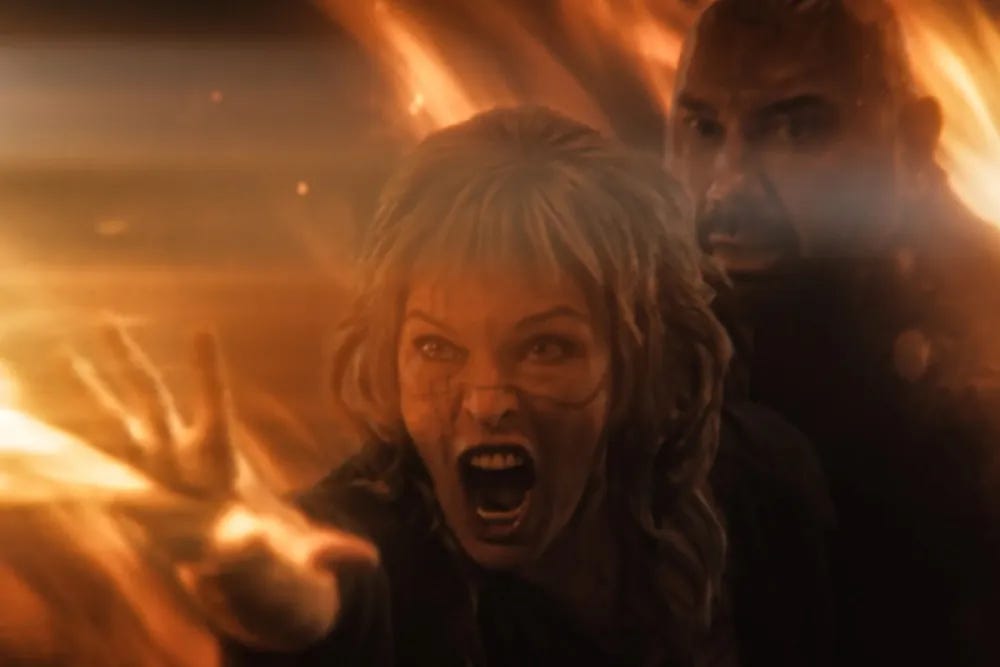In the Lost Lands is a heavy metal hellscape which erupts with belching smokestacks, doomed sorceresses, weepy werewolves, grave gunslingers, and flaming radioactive skeletons. This is somehow not a 1970s prog rock concept album - with an accompanying laser light show that plays at the local planetarium - but instead the latest post-apocalyptic film from director Paul W.S. Anderson, adapting a George R.R. Martin short story, and starring his wife Milla Jovovich.
It feels like a culmination of Anderson’s pulp oeuvre, collecting all of his obsessions: corrupt fascistic rulers, industrial cities gone to seed, cool fucking monsters, while mapping these dead spaces and letting Milla explore and destroy them. It is your classic cartographer/explorer relationship. It is the seventh collaboration between the husband-and-wife duo, but the first time Jovovich has taken a producer credit. As Paul stated in my interview in Screen Slate, Jovovich is a huge fan of fantasy, and she brought the project to his attention, shepherding it through development and starring as the cursed sorceress Gray Alys, who must grant every wish brought to her, whether or not it will bring doom.
Jovovich told Purple Magazine that, as a kid, she “liked reading Japanese comics and seeing ninjas swooping from tree to tree. I wanted to have that kind of control over my body, the kind dancers and martial artists have. It fascinated me.” Anderson has given her the opportunity to hone that skill over the course of the six-film Resident Evil franchise, and now she has gained a presence of violence, a glance as good as a punch. And In the Lost Lands finds her gaze landing on humans who only seem to wish for their own destruction.
Her side-saddle partner in this tour of woe is Boyce (Dave Bautistsa), a feared hunter, and one of the few humans who roams the Lost Lands outside of the central city, as they crawl with demonic, mutated presences. The latest wish that Gray Alys must grant is from the power-hungry Queen, who wants to absorb the power of a shapeshifter, a werewolf. Only Boyce could lead Gray Alys there. The Queen is waiting for the sick king to die, and fully take the reins of power, which for now reside in the hands of the fundamentalist freaks led by The Patriarch (Fraser James), who has tasked his true believer Enforcer (Arly Jover) with annihilating Gray Alys, who he believes is a destabilizing force in his decrepit kingdom.
The narrative line follows a train track through the rotting remnants of humanity, allowing Anderson to create one of his beloved maps, tracking their progress through evocative video game level names like “Shadows Bane”, “Fire Fields” and “Skull River”. Wind turbines loom as silent sentinels of failure, while decaying nuclear power plants are the new mountains. Anderson and his long-time visual effects supervisor Dennis Berardi built out the bluescreen backgrounds before they started shooting, as he breaks down in Screen Slate:
We built all of the backgrounds before we started principal photography and had real-time rendering and playback so that the virtual camera, and the real camera, were slaved together. So, when you move the real camera, the virtual backgrounds move as well. The actors could see the environments they were in, and the camera operators could see what the environments looked like and frame appropriately. The DP could light appropriately as well.
For all the complaints of flat lighting in modern effects films - In the Lost Lands is a riot of chiaroscuro - it his most wildly stylized film, painterly in its attention to light and shadow. And while Anderson was thinking of Bosch, I would place it more in the lineage of Frank Frazetta. There are so many gnarly details, like the two-headed rattlesnake that winds itself around Boyce’s shotgun, that it should be watched with devil’s horns raised
I first wrote about Paul W.S. Anderson in 2009 for IFC News, comparing him to the prolific Golden Age of Hollywood director W.S. Van Dyke (The Thin Man). Van Dyke’s advice to a young Orson Welles was to “just keep it close, and keep it moving.” I found this same sense of hurtling momentum in Anderson’s work at the time, and while that sense of pace remains (In the Lost Lands is, at its heart, a chase film), he is no longer keeping it close, instead continually pulling back to reveal more grotesque details of our appetite for self-destruction.
=====================================================================
So as you may have noticed, I am starting one of these Substack things. I have found it more and more difficult to get articles published about the niche-of-a-niche subjects I am interested in. Especially so because everything is tied to timeliness, and in my current phase of aging dad life I am always late to everything. So that is why I am calling this Old New. By the time I get to it the new stuff will be old, and I hope my approach to the old stuff will make it new again. If you ever read my long dead weekly column for Turner Classic Movies’ Movie Morlocks, this should be something like that. And if you haven’t - you can check it out here! So let’s see what happens. You’ll get a lot of reviews of South Asian cinema, DTV action movies, whatever jazz or metal shows I can find time to see, professional wrestling, and emotional purging sessions about the bane of my existence, the Buffalo Bills.






